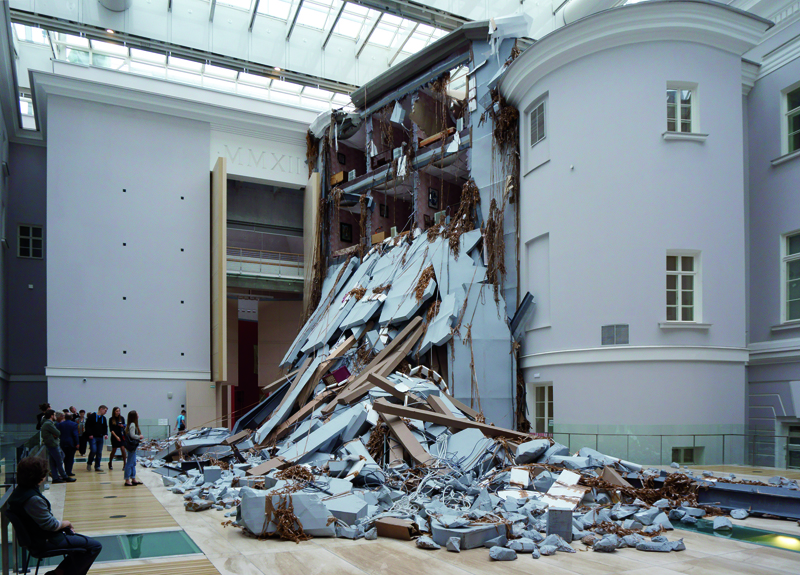
“Manifesta without a manifest” — this catch phrase became a famous play on words among art-critics in Saint-Petersburg. “Tenth biennale of contemporary art “Manifesta” turned out to be just a large but average exposition” — that’s the translated fragment from the internet-article by Pavel Gerasimenko — a local art-critic. “Quite old-fashioned, but much trusted concept of integration of contemporary art into traditional context tends to lose the sense, when the context remains just a “frame” — he concludes.
Manifesta was definitely much anticipated project in Saint-Petersburg. It’s true that most local art-critics, artists and intellectuals dreamed of something absolutely wonderful and sensational — a breakthrough, a flow of extremely fresh air from a wide-opened window. These aspirations unfortunately look like an obvious legacy of a Soviet Era way of thinking, based on international isolation of Soviet Union and deep provincialization of USSR culture.
Personally I expected a good entertainment and a nice portion of fresh intellectual “food”. Manifesta-10, to my opinion, became a “trial-version” of a “shareware program” of metropolitan cultural life in context of contemporary art, which was rapidly installed and run on “hardware” of Petersburg. Such type of cultural life is quite an ordinary feature of some European and Asian capitals — like Berlin, for example. But it’s still something new and quite unusual for a city with millions of old museums and tons of heritage — like Saint-Petersburg, which has no big museums of contemporary art and no world-famous art-galleries affecting the Global Market. The trial period ends too soon — that’s definitely the problem, when it comes to shareware applications. Simulation ends so rapidly. What’s next? You have to pay and buy the program or find and download a crack or serial, possibly. What do you have to do with shareware culture? You have to buy a ticket to Berlin with its 600+ art-galleries? You cannot “install” a cultural life with single click on hardware of your city like an application for your smartphone. “Patching” and “cracking” technologies are for underground art scene — but not for common local citizens.
Manifesta-10, of course, became a unique chance for young artists to demonstrate their works of art to a really wide audience. Especially the enormous parallel program sites, introduced as art-spaces for the first time in 2014, became quite helpful. But due to significant lack of time and money young artists presented mostly old works or tried to make something new — in fast-and-hard mode.
Parallel sites of Manifesta-10 remind me of an annual Saint-Petersburg contemporary art fest held by Pro-Arte Foundation and entitled “Contemporary art in traditional museum”. Last autumn we had a 10th anniversary of this festival. The idea of “CAITM” is quite simple: they choose about 10…15 institutions from the endless list of Petersburg museums and create some new contemporary art projects there. Really nice fest, I have to say.
Manifesta-10 opened and re-discovered many interesting mysterious and forgotten places like former Military Cadet Corps College, secret military industry design bureau of strategic “Signal” factory, former plastics factory and a lot more. But 100-years old formula “Bring anything to a museum and it becomes a contemporary art” had led to a kind of a paradox in case of Manifesta-10 parallel sites exhibitions. The old formula, used by Pro-Arte annually, worked inside out this time. The artworks by young artists, demonstrating constant lack of so-called “substance of art form”, got literally lost inside the giant semi-abandoned interiors and yards of former scientific, educational and industrial buildings, which belong to an era of powerful, solid and determined “Great Lost Culture”. These giant shells left by inhabitants were fulfilled with really strong crowds of people during the first opening days of Manifesta 2014. It was interesting and embarrassing — to be inside these moving people-aunt-hills, while trying to find some works of art inside the strange caves of abandoned structures. It was nice.
The main exhibition was installed inside the recently converted halls of former famous administrative General Staff Building, dating back to early XIX century. This main program exposition definitely looks like gentle and intellectually-based project of a very high quality, which The Hermitage deserves. Saint-Petersburg rarely receives contemporary exhibitions of such level. But I have to mention that I didn’t find anything of that level of impression, which I had got when Jake & Dinos Chapman brought their “End of Fun” project to the same halls in 2012. Though, some significant works — like a giant ruined building simulation by Thomas Hirschhorn and really nice surprisingly authentic, meticulously developed mixed-genre work by Francis Alÿs bring some very nice flavor. I like the way of interaction between the interiors of General Staff and Manifesta-10 main exhibition artifacts. Carefully installed artifacts bring new feeling of scale and new environment to a museum, architecturally based on a dreams and tries of nearly neo-Piranesian way of space modeling.
I’m glad that Manifesta came to SPb this year. This valuable fest helps to define and give a significant relief to constant infrastructural paradoxes of cultural environment of contemporary Piter-city. The city receives another important signal for re-modeling and modernization of cultural “hardware”. Build a couple of nice World-class contemporary art museums and maybe the city will receive a constant “license” to act on contemporary art scene instead of installing and evaluating trial-versions like “shareware”-Manifesta.
Alexander Strugach
architecte, CEO
PDG de SIMMETRIA
Poster un Commentaire